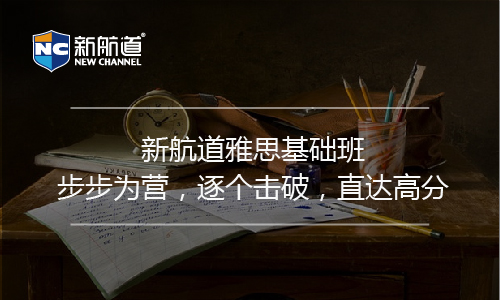劍5Test4雅思閱讀Passage2譯文-殘缺美:鋼化玻璃的問題
2017/5/15 10:38:41來源:新航道作者:新航道
摘要:上海新航道雅思小編發(fā)布劍5Test4雅思閱讀Passage2譯文-Flawed Beauty: the problem with toughened glass,希望幫助考生對照文本更好的研究真題,充分備考,爭取理想成績,實(shí)現(xiàn)留學(xué)夢想。
上海新航道雅思小編發(fā)布劍5Test4雅思閱讀Passage2譯文-Flawed Beauty: the problem with toughened glass,希望幫助考生對照文本更好的研究真題,充分備考,爭取理想成績,實(shí)現(xiàn)留學(xué)夢想。

Flawed Beauty: the problem with toughened glass
殘缺美:鋼化玻璃的問題
On 2nd August 1999, a particularly hot day in the town of Cirencester in the UK, a large pane of toughened glass in the roof of a shopping centre at Bishops Walk shattered without warning and fell from its frame. When fragments were analysed by experts at the giant glass manufacturer Pilkington, which had made the pane, they found that minute crystals of nickel sulphide trapped inside the glass had almost certainly caused the failure.
1999年8月3號,天氣異常炎熱,在英國小鎮(zhèn)賽倫塞斯特上,位于主教街的一家購物中心屋頂上的一大片鋼化玻璃在沒有任何征兆的情況下突然裂成碎片并掉了下來。隨即,其生產(chǎn)者——大型玻璃制造商Pilkington公司的專家對掉落的碎片進(jìn)行了分析。經(jīng)過分析,專家?guī)缀醮_定這次事故是由玻璃內(nèi)部硫化鎳的微型晶體引起的。
‘The glass industry is aware of the issue,’ says Brian Waldron, chairman of the standards committee at the Glass and Glazing Federation, a British trade association, and standards development officer at Pilkington. But he insists that cases are few and far between. ‘It’s a very rare phenomenon,’ he says.
“玻璃行業(yè)已經(jīng)意識到了這個問題。”英國貿(mào)易協(xié)會之一——玻璃及玻璃裝配協(xié)會標(biāo)準(zhǔn)委員會主席,同時也是Pilkingtcm公司標(biāo)準(zhǔn)發(fā)展官員的Brian Waldron宣稱。但是他堅持認(rèn)為這種情況只不過是滄海一粟罷了。“這是非常罕見的現(xiàn)象。”他說。
Others disagree. ‘On average I see about one or two buildings a month suffering from nickel sulphide related failures,’ says Barrie Josie, a consultant engineer involved in the Bishops Walk investigation. Other experts tell of similar experiences. Tony Wilmott of London-based consulting engineers Sandberg, and Simon Armstrong at CladTech Associates in Hampshire both say they know of hundreds of cases. ‘What you hear is only the tip of the iceberg,’ says Trevor Ford, a glass expert at Resolve Engineering in Brisbane, Queensland. He believes the reason is simple: ‘No-one wants bad press.’
但不同意見也同時存在。參與主教街事件調(diào)查的咨詢工程師Barrie Josie宣稱,“平均每個月我都會看到一兩幢建筑物遭遇類似的硫化鎳問題。”其他專家也講述了類似經(jīng)歷。位于倫敦的Sanberg公司的咨詢工程師Tony Wilraott以及來自漢普西爾的CladTech協(xié)會的Simon Armstrong均聲稱自己了解大量此類情況。“公眾所知道的只不過是冰山一角罷了,”昆士蘭州布里斯班市Resolve工程公司的玻璃專家Trevor Ford說道。他認(rèn)為原因很簡單:“沒人想要壞新聞。”
Toughened glass is found everywhere, from cars and bus shelters to the windows, walls and roofs of thousands of buildings around the world. It’s easy to see why. This glass has five times the strength of standard glass, and when it does break it shatters into tiny cubes rather than large, razor-sharp shards. Architects love it because large panels can be bolted together to make transparent walls, and turning it into ceilings and floors is almost as easy.
鋼化玻璃被廣泛應(yīng)用于汽車、候車亭以及世界各地數(shù)以千計的建筑物上的窗子、墻面和屋頂。原因很簡單,鋼化坡璃的強(qiáng)度是普通玻璃的5倍,破碎時裂成細(xì)小顆粒而不是鋒利的大塊碎片。大塊的鋼化坡璃可以拼成透明的玻璃墻,用它做屋頂和地面也很方便,所以建筑師對鋼化玻璃情有獨(dú)鐘。
It is made by heating a sheet of ordinary glass to about 620°C to soften it slightly, allowing its structure to expand, and then cooling it rapidly with jets of cold air. This causes the outer layer of the pane to contract and solidify before the interior. When the interior finally solidifies and shrinks, it exerts a pull on the outer layer that leaves it in permanent compression and produces a tensile force inside the glass. As cracks propagate best in materials under tension, the compressive force on the surface must be overcome before the pane will break, making it more resistant to cracking.
鋼化玻璃是由普通玻璃制成的:把一塊普通玻璃加熱到大約620攝氏度,使之輕度軟化、結(jié)構(gòu)膨脹,然后用冷氣流迅速將其冷卻。這導(dǎo)致玻璃的外層先于內(nèi)部收縮和凝固。玻璃內(nèi)部最終冷卻并凝固后對玻璃外層產(chǎn)生拉力作用,使之始終處于壓力之下,它還會使玻璃內(nèi)部產(chǎn)生張力.裂縫最容易在有壓力的物體中擴(kuò)張,所以要防止玻璃破晬就必須消除玻璃表面的壓力,使之不容易破碎。
The problem starts when glass contains nickel sulphide impurities. Trace amounts of nickel and sulphur are usually present in the raw materials used to make glass, and nickel can also be introduced by fragments of nickel alloys falling into the molten glass. As the glass is heated, these atoms react to form tiny crystals of nickel sulphide. Just a tenth of a gram of nickel in the furnace can create up to 50,000 crystals.
當(dāng)玻璃含有硫化鎳雜質(zhì)時,問題就出現(xiàn)了。痕量的鎳和硫通常出現(xiàn)在制作玻璃的原材料中,熔化過程中鎳合金碎片也會增加玻璃的鎳含量。玻璃被加熱之后,這些原子相互作用形成了微型的硫化鎳晶體。熔爐中0.1克的鎳就會產(chǎn)生多達(dá)5萬個晶體。
These crystals can exist in two forms: a dense form called the alpha phase, which is stable at high temperatures, and a less dense form called the beta phase, which is stable at room temperatures. The high temperatures used in the toughening process convert all the crystals to the dense, compact alpha form. But the subsequent cooling is so rapid that the crystals don’t have time to change back to the beta phase. This leaves unstable alpha crystals in the glass, primed like a coiled spring, ready to revert to the beta phase without warning.
這些晶體以兩種形式存在:髙溫下穩(wěn)定的密度較大的α相和室溫下穩(wěn)定的密度小一些的β相。強(qiáng)化過程中的高溫把所有的硫化鎳晶體都轉(zhuǎn)化成高密度的α相。但是接下來的冷卻過程如此迅速,以至于硫化鎳晶體沒有足夠的時間重新轉(zhuǎn)化成β相。這在玻璃中遺留下不穩(wěn)定的α相晶體,它就像被壓縮的彈簧一樣隨時可能毫無征兆地重新轉(zhuǎn)化為β相。
When this happens, the crystals expand by up to 4%. And if they are within the central, tensile region of the pane, the stresses this unleashes can shatter the whole sheet. The time that elapses before failure occurs is unpredictable. It could happen just months after manufacture, or decades later, although if the glass is heated — by sunlight, for example — the process is speeded up. Ironically, says Graham Dodd, of consulting engineers Arup in London, the oldest pane of toughened glass known to have failed due to nickel sulphide inclusions was in Pilkington’s glass research building in Lathom, Lancashire. The pane was 27 years old.
當(dāng)硫化鎳晶體由α相轉(zhuǎn)化成β相時,體積膨脹4%。如果α相晶體位于張力最大的玻璃中央,膨脹產(chǎn)生的壓力可以使整塊玻璃破裂。破裂時間無法預(yù)測,可能是生產(chǎn)出來的幾個月后也可能是幾十年后,盡管玻璃被日光加熱會加快晶體的轉(zhuǎn)化速度。Graham Dodd,倫敦Arup顧問建筑師說:“具有諷刺意味的是,因?yàn)楹辛蚧嚩鴮?dǎo)致破裂的‘歷史最悠久’的鋼化玻璃是蘭開夏郡拉蘇的Pilkington公司的玻璃研究大廈的玻璃,使用時間是27 年。”
Data showing the scale of the nickel sulphide problem is almost impossible to find. The picture is made more complicated by the fact that these crystals occur in batches. So even if, on average, there is only one inclusion in 7 tonnes of glass, if you experience one nickel sulphide failure in your building, that probably means you’ve got a problem in more than one pane. Josie says that in the last decade he has worked on over 15 buildings with the number of failures into double figures.
能夠表明硫化鎳問題的規(guī)模的數(shù)據(jù)幾乎無法找到。硫化鎳晶體總是成批出現(xiàn),使問題更加復(fù)雜。所以,即使平均每7噸的玻璃里只有一個雜質(zhì),但是,只要有一個硫化鎳晶體發(fā)生破裂,這就意味著這個建筑物中不止一塊鋼化玻璃存在著問題。Josie說,在過去的十年間,他參加建造的建筑物超過15個,因?yàn)榱蚧嚠a(chǎn)生問題的建筑物數(shù)量達(dá)到兩位數(shù)。
One of the worst examples of this is Waterfront Place, which was completed in 1990. Over the following decade the 40-storey Brisbane block suffered a rash of failures. Eighty panes of its toughened glass shattered due to inclusions before experts were finally called in. John Barry, an expert in nickel sulphide contamination at the University of Queensland, analysed every glass pane in the building. Using a studio camera, a photographer went up in a cradle to take photos of every pane. These were scanned under a modified microfiche reader for signs of nickel sulphide crystals. ‘We discovered at least another 120 panes with potentially dangerous inclusions which were then replaced,’ says Barry. ‘It was a very expensive and time-consuming process that took around six months to complete.’ Though the project cost A$1.6 million (nearly £700,000), the alternative — re-cladding the entire building — would have cost ten times as much.
一個最糟糕的例子就是建于1990年的Waterfront Place。在建成后的10年間,這個位于布里斯班的40層的大樓經(jīng)歷了一系列的毀壞。在專家最終到來之前,因?yàn)榱蚧囯s質(zhì)的問題,有80塊鋼化玻璃破碎。昆士蘭大學(xué)的硫化鎳專家Barry分析了大廈所有的鋼化玻璃。攝影師乘吊車用室內(nèi)攝像機(jī)拍下了毎一塊鋼化玻璃,之后這些照片被放在改良縮微膠片閱讀機(jī)上掃描以檢測硫化鎳的痕跡。“我們發(fā)現(xiàn)至少還有120塊鋼化玻璃存在可能導(dǎo)致危險的雜質(zhì),這些玻璃都需要更換,”Bairy說:“這是一個昂貴的、非常耗費(fèi)時間的過程,大約需要6個月的時間才能完成。”雖然這項工程花費(fèi)了160萬澳幣(相當(dāng)于70萬英鎊),但重新修復(fù)整個大廈所需的花費(fèi)將會是這個費(fèi)用的10倍。
以上就是小編為大家?guī)黻P(guān)于《劍橋雅思5真題》閱讀供大家閱讀參考,新航道雅思資料頻道將第一時間為考生發(fā)布最全、最新、最專業(yè)的雅思資訊及雅思考試資料及機(jī)經(jīng).
免費(fèi)獲取資料
熱門搜索: 上海雅思培訓(xùn)哪家好| 上海雅思封閉班| 上海雅思一對一培訓(xùn)| 雅思全日制培訓(xùn)| 上海新航道| 2022年雅思寫作話題題庫+范文|
熱報課程
- 雅思課程
| 班級名稱 | 班號 | 開課時間 | 人數(shù) | 學(xué)費(fèi) | 報名 |
|---|
免責(zé)聲明
1、如轉(zhuǎn)載本網(wǎng)原創(chuàng)文章,情表明出處
2、本網(wǎng)轉(zhuǎn)載媒體稿件旨在傳播更多有益信息,并不代表同意該觀點(diǎn),本網(wǎng)不承擔(dān)稿件侵權(quán)行為的連帶責(zé)任;
3、如本網(wǎng)轉(zhuǎn)載稿、資料分享涉及版權(quán)等問題,請作者見稿后速與新航道聯(lián)系(電話:021-64380066),我們會第一時間刪除。
全真模擬測試
雅思動態(tài)

DeepSeekx雅思官方:中國考生...
制作:每每







